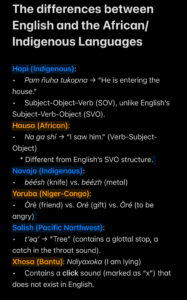Week 5: Lost and Found in Translation
Connor R -
Welcome back, readers! I hope you had a happy Saint Patrick`s Day. I have emailed and texted all 4 people who requested interviews, but none have gotten back to me. I sent them my contact information, so I hope they reach out. After tomorrow, I will email my mentor to contact them because I feel like my email is hidden in their spam folder. So, while I wait to schedule interviews, I want to discuss my research on African and Indigenous languages and why they are so hard to understand.
To start, African languages are generally difficult for native English speakers due to their lack of structural similarity with English. West African languages, such as Wolof and Hausa, are particularly challenging due to their stark contrasts with English. Eastern and Central African languages, including Bantu and Nilotic languages, have complex grammar and pronunciation that native English speakers can`t break down. In Southern Africa, click languages are almost impossible to understand without a basic understanding, which most people don`t have. Out of all African languages, Swahili is recommended as the easiest African language to understand due to its widespread use and accessibility for practice.
Native American languages are often challenging for adult English speakers due to unfamiliar vocabulary, complex grammar, and unique pronunciation. Many are agglutinative, combining multiple meanings into single words, and some feature sounds uncommon in English. Learning resources and fluent speakers can be scarce, with better-documented options like Lakota, Hawaiian, and Navajo being more accessible. However, the most difficult languages to learn are those that are extinct, such as Massachusett and Susquehannock, which have little surviving documentation beyond word lists. Without grammar, pronunciation guides, or cultural context, these languages are effectively impossible to reconstruct.
In Tucson, several Indigenous communities including the Tohono O’odham and Yaqui are present. There are many Language revitalization efforts, but the intergenerational loss of fluency has created gaps in communication. Similarly, African immigrants may face difficulties maintaining their native languages while adapting to English, especially if their languages are less documented or less spoken in their location. Here are some examples of these differences.

In short, the vast differences in grammar, vocabulary, and pronunciation make the African and Indigenous languages quite formidable to translate and understand. While doing some brainstorming, a potential solution is partnering with Indigenous and immigrant communities to help design programs that truly address the needs of African and Indigenous language speakers. Another idea is to expand the number of languages covered in the translation and interpreting devices at the hospital. Next week, I will hopefully have my interviews scheduled and/or completed and will be able to break them down with you guys. After that, I can resume my search for solutions. See you next week!

Comments:
All viewpoints are welcome but profane, threatening, disrespectful, or harassing comments will not be tolerated and are subject to moderation up to, and including, full deletion.